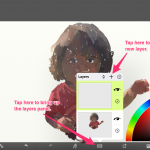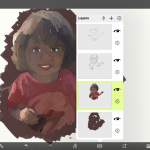INSPIRED IDEAS – Explore the portrait
René, you’re such a poseur…
“René used to tell us how no sooner had he put his books down when he got in from school than Edgar would grab him and make him pose”
Paul-André Lemoisne, 1931
This portrait of Edgar’s youngest sibling, the 10 year old René, was painted in 1855. Degas’s family members were his principal models in his early years and René was one of his favourite models.
- Describe what you see in the painting. What can you learn about René and his life from what you see?
- Imagine being a 10 year old boy in 1855 and write a diary entry about a day in your life, using clues from the painting.
- If René was alive today what might René be wearing and what might be in the background?
- This painting of René is a realistic portrait. Find two portraits that are not realistic in style. You could consider portraits by Edvard Munch (1863-1944) or Pablo Picasso (1881-1973). Compare these two works with the portrait of René. How does the purpose and style of each of these works compare with ‘René De Gas’?
- How does the purpose and style of this portrait compare with a ‘selfie’?
- This is a three-quarter portrait. Make a copy of this painting and extend it to be a full-length portrait to show how René is standing and what else is in the room.
- Explore how shadow and tone can change the mood of a portrait. Enlarge and colour photocopy ‘René De Gas’. Paste it onto a piece of cardboard. Cover the cardboard with PVA glue. After the glue has dried cover the whole painting with black paint. Before the black paint dries scrape or wipe away some of the black areas to reveal parts of the original portrait. What mood or ideas does your work communicate and how it is different to the original?
DIG DEEPER – A portrait is a dialogue…
Degas was only 21 years of age when he painted this portrait of his younger brother. Degas maintained an interest in portraiture throughout his career.
Every time I look at this portrait I am drawn by the intensity of René’s stare. It is interesting to think about a portrait as a dialogue; a dialogue between sitter and artist and also a dialogue between sitter and viewer. The artist aims to communicate something about the sitter by the way the sitter is portrayed, yet as I look at this portrait I seem to be more interested in what Degas was thinking as he was painting it. What do we learn about Degas the artist as we admire this portrait?
Consider the following statements by Degas. How does each statement help us understand the artist behind the portrait?
The secret is to follow the advice the masters give you in their works while doing something different from them.
Drawing is not the same as form; it is a way of seeing form.
Art is not what you see, but what you make others see.
DIGITAL ARTIST
Paint like the masters…but without the mess
Creating an original oil painting can be tough. You need a range of oil paints, a canvas, and a willing model prepared to sit for hours on end. Degas had all of these things, but you know what? He didn’t have a tablet…computer.
We are going to take our first steps into portrait oil painting…digitally, using digital art mediums and layers (layers is the ability to add multiple layers on your artwork, kind of like putting over a clear piece of canvas over your work)
As we want to start focusing on the techniques, we are going to take a few ‘shortcuts’ in our portrait today.
In this lesson we will be using the app ArtRage.
Links:
iOS – ArtRage
Android – ArtRage
Steps:
- Open the ArtRage app on your device.

- Tap the third icon from the right to load a tracing image. Tap the + icon to get your image.

- You can choose to take a photo (if your model is handy) or choose one from your device.

- Choose the oil brush.
- Now the shortcut, as you paint your strokes the app will automatically choose the correct colour from the photo in the tracing layer. So use small strokes to get a greater colour range. Remember we are just practising our portrait painting. Try and paint with brush thickness and stroke direction you would do with a real painting.

- Once you are happy with your paint layer, create a new layer.

- Change your brush to the pencil. To make the features stand out more, draw over your painting with light lines. Focus on the outline of your portrait and all the features in the face.

- Want to add some highlights and shadows? Create a new layer and use the the paint brush again. When you use new layers, you can add details and effects without affecting the work in the other layers, easy if you make a mistake (traditional painters, if they made mistakes or just simply changed their mind would paint over those elements).
- Once you are happy with your portrait, save the image to your device to email or print.